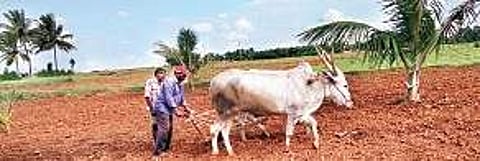

BENGALURU: While the world focuses on quinoa and kale to meet its nutrient needs, a few locals and experts have been calling for local, season-based produce as the ticket to health. The way they are going about this is by adopting zero budget natural farming (ZBNF), a technique that ensures low cost and high quality.
Mahesh Patel, a software engineer who has a farm in Gulbarga, adopted ZBNF more than a year back. “The input costs for agriculture are almost negligible, and the profits only increase every year. The quality of my produce has also gotten better,” he says. Patel says that the toor dal he cultivates has customers coming back for more.
Vinayak Gajendragad, a former techie, has devoted his time to ZBNF, to bring quality produce to his consumers. He says that though there hasn’t been too much difference in the yield, the quality of his produce and the fertility of the soil has drastically improved, “ he says.
Benefits of ZBNF
Prasanna Murthy of the MHR Foundation of India, which educates people on the benefits of ZBNF, believes that if nature is allowed to work her wonders, farmers and consumers won’t have to look too far for economically viable farming solutions and nutritious, chemical-free produce.
“Consumers detach themselves from agriculture completely and believe that they have nothing to do with it. This is where awareness about zero budget natural farming (ZBNF) can help reduce this knowledge gap,” he says.
Mallikarjuna, a trustee at the MHR Foundation of India, vouches strongly for ZBNF. This method of farming is largely dependent on microorganisms in the soil, intercropping and using minimal water to produce good quality yield in large amounts. “The idea is to replenish soils with microorganisms naturally. Soil that is too alkaline or acidic can yield slow results, but the right balance will be restored by using microorganisms,” says Murthy.
Murthy promotes the usage of the right kind of materials for ZBNF, which include cow dung, and cow urine.
“The local cow is the best source of agricultural material, as it is resilient and can adapt well to the Indian climate and circumstances. Imported cows fall sick every few weeks and require constant antibiotic treatment. This also contaminates the milk we drink,” he says.
In their bid to educate farmers, Murthy, along with other members from the foundation, reach out to famers in Karnataka and use various methods to get their message across. “Many farmers have benefited from ZBNF. It is not a market-oriented technique, but still brings profits to the farmers,” adds Murthy.
According to Murthy, the lack of nutrition in our produce is harming consumers in more ways than one, and the middle-class Indian is the most affected.
In areas like Bagalkot, there are numbers indicating that girls are hitting puberty much before they ideal age. Murthy attributes this to the contamination of produce and milk products.
ZBNF has ensured far higher yields than what is found in the rest of the country through traditional farming. “We get five times more produce in paddy than what the traditional method is yielding,” says Murthy, adding that it is a completely scientifically backed technique that uses jeevamruta (an organic fertilizer made from cow dung), mulching and the right usage of water. They use less than 10% of external water resources, and rely completely on solar energy.
The MHR Foundation holds workshops for children and adults in the city every Sunday.
What Is Zero Budget Natural Farming
ZBNF is all about making use of things easily available at a farm to minimize expenditure
Dung and urine from local varieties of cow are used
Seeds are sprinkled with beejamrut, a mixture of cow dung, cow urine, lime and water,
before sowing
After sowing, fields are sprinkled with jeevamrut, a fermented mixture of cow dung, cow urine, jaggery, gram flour and soil
A layer of dead leaves, twigs, branches, etc, are laid over the field to activate earthworms
Intercrops and mixed crops are then used to stimulate symbiosis
Pesticides and insecticides are made from ingredients like garlic, neem leaves, chilli and cow excreta